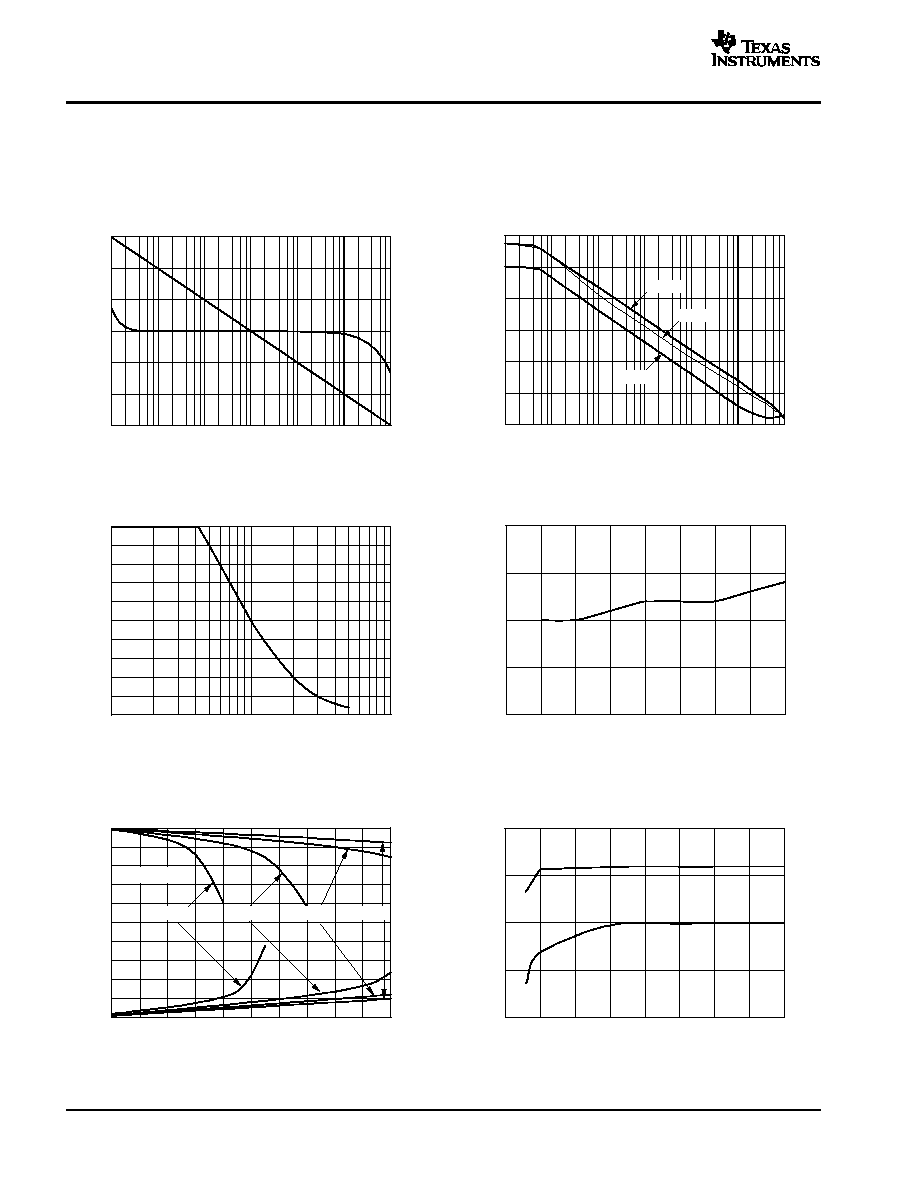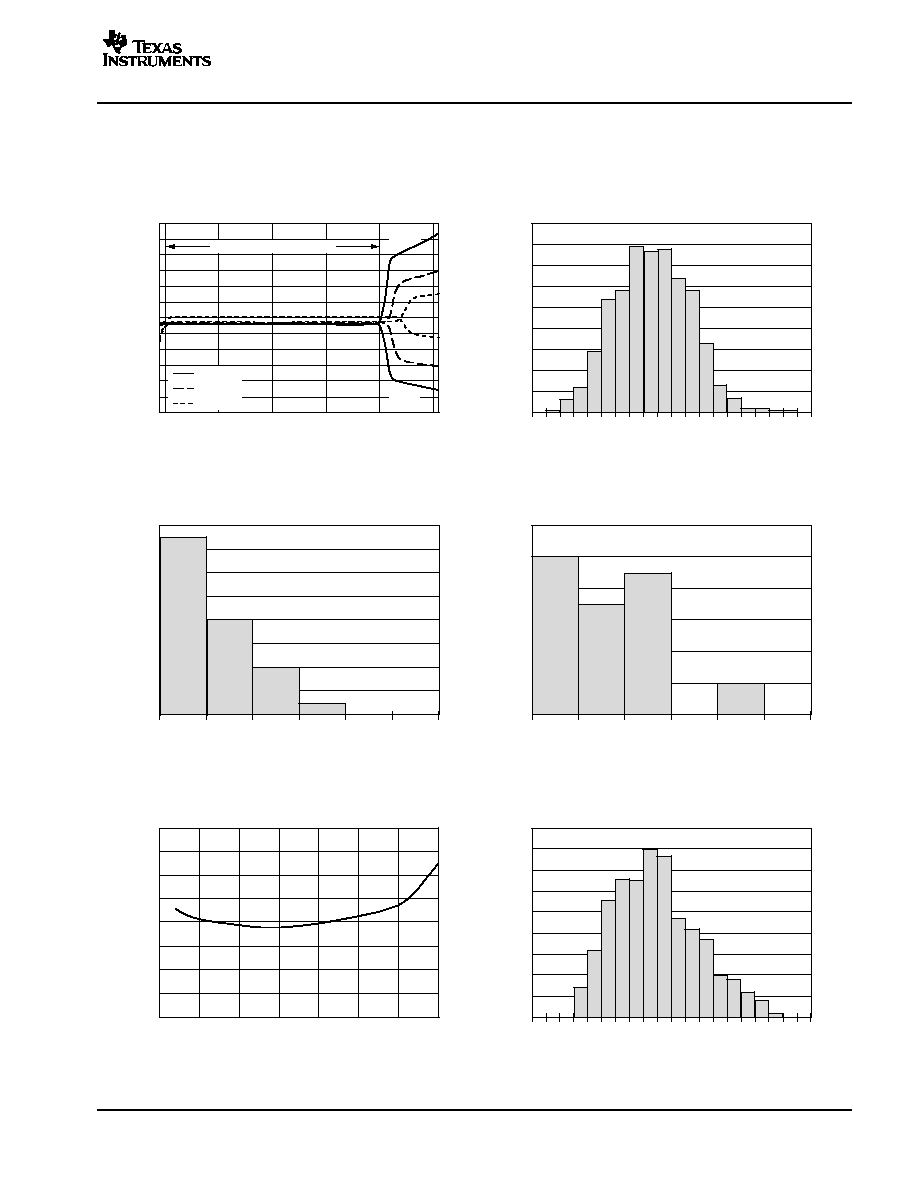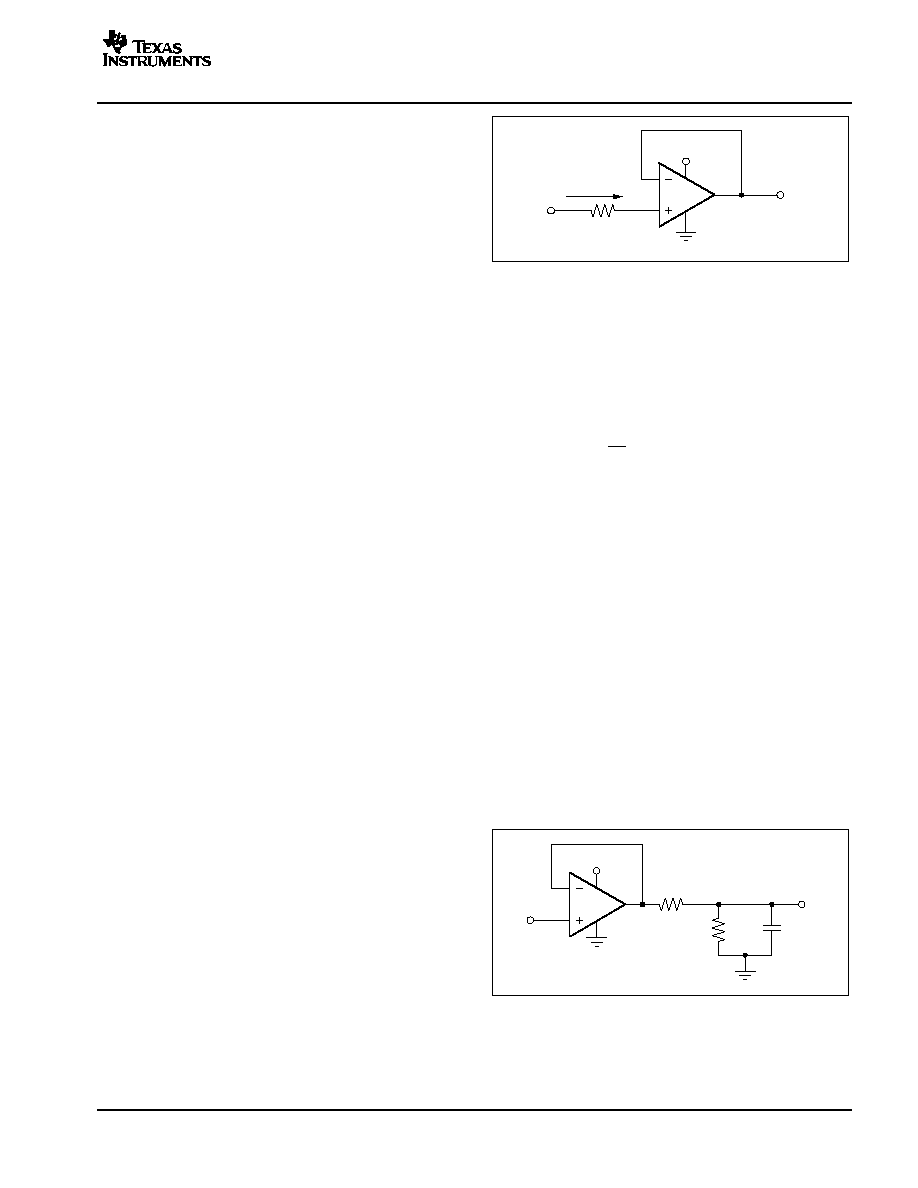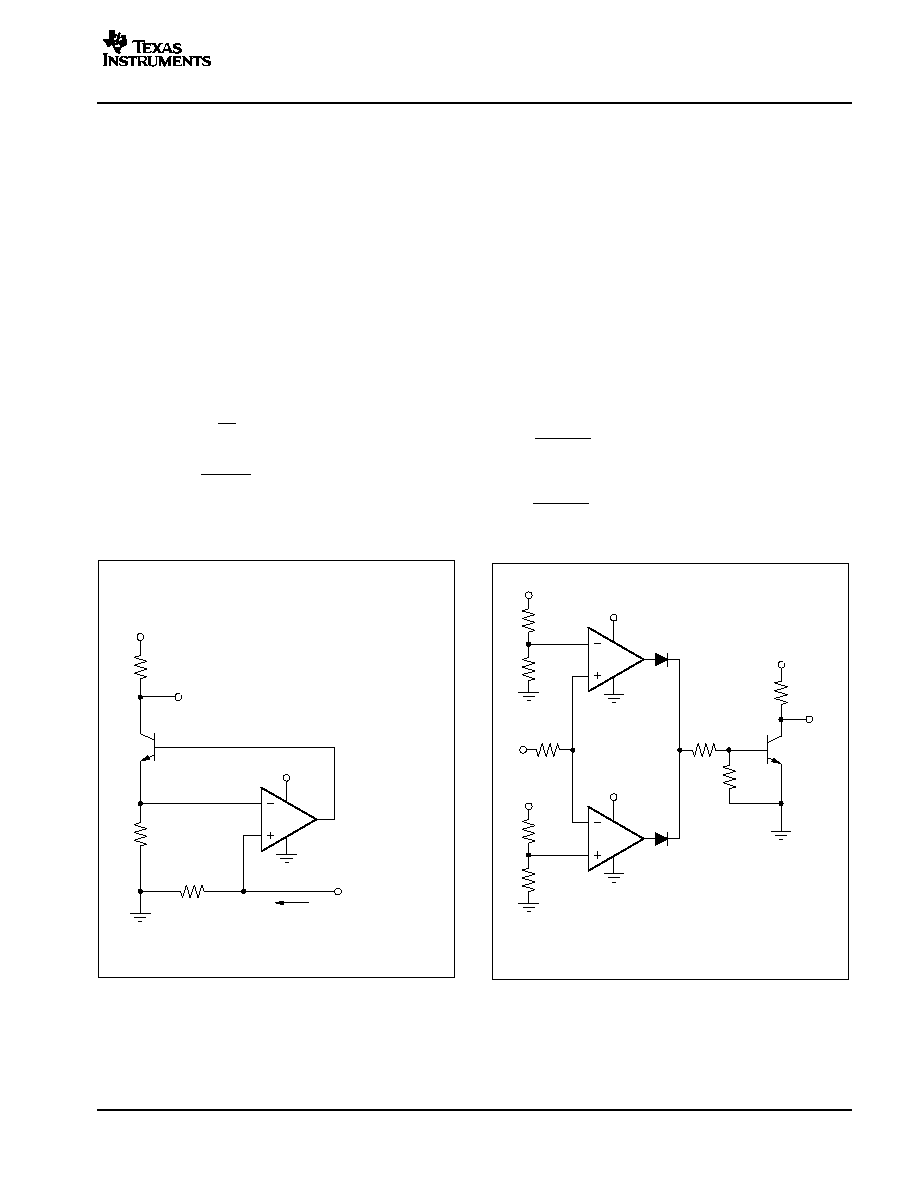 | –≠–ª–µ–∫—Ç—Ä–æ–Ω–Ω—ã–π –∫–æ–º–ø–æ–Ω–µ–Ω—Ç: OPA2379 | –°–∫–∞—á–∞—Ç—å:  PDF PDF  ZIP ZIP |

FEATURES
D
LOW NOISE: 2.8
µ
V
PP
D
microPower: 5.5
µ
A (max)
D
LOW OFFSET VOLTAGE: 1.5mV (max)
D
DC PRECISION:
- CMRR: 100dB
- PSRR: 2
µ
V/V
- A
OL
: 120dB
D
WIDE SUPPLY VOLTAGE RANGE: 1.8V to 5.5V
D
microSize PACKAGES
APPLICATIONS
D
BATTERY-POWERED INSTRUMENTS
D
PORTABLE DEVICES
D
MEDICAL INSTRUMENTS
D
HANDHELD TEST EQUIPMENT
DESCRIPTION
The OPA379 family of micropower, low-voltage
operational amplifiers is designed for battery-powered
applications. These amplifiers operate on a supply voltage
as low as 1.8V. High-performance, single-supply
operation with rail-to-rail capability makes the OPA379
family useful for a wide range of applications.
In addition to microSize packages, the OPA379 family of
op amps features impressive bandwidth (90kHz), low bias
current (25pA), and low noise (80nV/
Hz) relative to the
very low quiescent current (5.5
µ
A max).
The OPA379 (single) is available in SC70-5, SOT23-5,
and SO-8 packages. The OPA2379 (dual) comes in
SOT23-8 and SO-8 packages. The OPA4379 (quad) is
offered in a TSSOP-14 package. All versions are specified
from -40
∞
C to +125
∞
C.
OPAx379 RELATED PRODUCTS
FEATURES
PRODUCT
1
µ
A, 70kHz, 2mV V
OS
, 1.8V to 5.5V Supply
OPAx349
1
µ
A, 5.5kHz, 390
µ
V V
OS
, 2.5V to 16V Supply
TLV240x
1
µ
A, 5.5kHz, 0.6mV V
OS
, 2.5V to 12V Supply
TLV224x
7
µ
A, 160kHz, 0.5mV V
OS
, 2.7V to 16V Supply
TLV27Lx
7
µ
A, 160kHz, 0.5mV V
OS
, 2.7V to 16V Supply
TLV238x
20
µ
A, 350kHz, 2mV V
OS
, 2.3V to 5.5V Supply
OPAx347
20
µ
A, 500kHz, 550
µ
V V
OS
, 1.8V to 3.6V Supply
TLV276x
45
µ
A, 1MHz, 1mV V
OS
, 2.1V to 5.5V Supply
OPAx348
OPA379
OPA2379
OPA4379
SBOS347A - NOVEMBER 2005 - REVISED DECEMBER 2005
1.8V, 2.9
µ
A, 90kHz, Rail-to-Rail I/O
OPERATIONAL AMPLIFIERS
www.ti.com
Copyright
2005, Texas Instruments Incorporated
Please be aware that an important notice concerning availability, standard warranty, and use in critical applications of Texas Instruments
semiconductor products and disclaimers thereto appears at the end of this data sheet.
All trademarks are the property of their respective owners.
PRODUCTION DATA information is current as of publication date. Products
conform to specifications per the terms of Texas Instruments standard warranty.
Production processing does not necessarily include testing of all parameters.

OPA379
OPA2379
OPA4379
SBOS347A - NOVEMBER 2005 - REVISED DECEMBER 2005
www.ti.com
2
ABSOLUTE MAXIMUM RATINGS
(1)
Supply Voltage
+7V
. . . . . . . . . . . . . . . . . . . . . . . . . . . . . . . . . . . . . . .
Signal Input Terminals, Voltage
(2)
-0.5V to (V+) + 0.5V
. . . . . . . . .
Current
(2)
±
10mA
. . . . . . . . . . . . . . . . . . . .
Output Short-Circuit
(3)
Continuous
. . . . . . . . . . . . . . . . . . . . . . . . . .
Operating Temperature
-40
∞
C to +125
∞
C
. . . . . . . . . . . . . . . . . . . . .
Storage Temperature
-65
∞
C to +150
∞
C
. . . . . . . . . . . . . . . . . . . . . . .
Junction Temperature
+150
∞
C
. . . . . . . . . . . . . . . . . . . . . . . . . . . . . . .
ESD Rating
Human Body Model
2000V
. . . . . . . . . . . . . . . . . . . . . . . . . . . . .
Charged Device Model
1000V
. . . . . . . . . . . . . . . . . . . . . . . . . . .
(1) Stresses above these ratings may cause permanent damage.
Exposure to absolute maximum conditions for extended periods
may degrade device reliability. These are stress ratings only, and
functional operation of the device at these or any other conditions
beyond those specified is not supported.
(2) Input terminals are diode-clamped to the power-supply rails.
Input signals that can swing more than 0.5V beyond the supply
rails should be current-limited to 10mA or less.
(3) Short-circuit to ground, one amplifier per package.
This integrated circuit can be damaged by ESD. Texas
Instruments recommends that all integrated circuits be
handled with appropriate precautions. Failure to observe
proper handling and installation procedures can cause damage.
ESD damage can range from subtle performance degradation to
complete device failure. Precision integrated circuits may be more
susceptible to damage because very small parametric changes could
cause the device not to meet its published specifications.
ORDERING INFORMATION
(1)
PRODUCT
PACKAGE-LEAD
PACKAGE
DESIGNATOR
PACKAGE
MARKING
OPA379
(2)
SC70-5
DCK
AYR
OPA379
(2)
SOT23-5
DBV
AYQ
OPA379
SO-8
D
OPA379
OPA2379
(2)
SOT23-8
DCN
B61
OPA2379
SO-8
D
OPA2379
OPA4379
(2)
TSSOP-14
PW
OPA4379
(1) For the most current package and ordering information, see the
Package Option Addendum at the end of this document, or see
the TI web site at www.ti.com.
(2) Available Q1, 2006.
PIN CONFIGURATIONS
1
2
3
4
8
7
6
5
NC
(1)
V+
OUT
NC
(1)
NC
(1)
-
IN
+IN
V
-
OPA379
SO-8
1
2
3
4
5
6
7
14
13
12
11
10
9
8
OUT D
-
IN D
+IN D
V
-
+IN C
-
IN C
OUT C
OUT A
-
IN A
+IN A
V+
+IN B
-
IN B
OUT B
OPA4379
1
2
3
5
4
V+
OUT
+IN
V
-
-
IN
OPA379
NOTES:
(1) NC denotes no internal connection.
(2) Pin 1 of the SOT23-8 package is determined by orienting the package marking as shown.
(3) Available Q1, 2006.
1
2
3
4
8
7
6
5
V+
OUT B
-
IN B
+IN B
OUT A
-
IN A
+IN A
V
-
OPA2379
SC70-5
(3)
SOT23-5
(3)
SOT23-8
(2)(3)
SO-8
TSSOP-14
(3)
1
2
3
5
4
V+
-
IN
OUT
V
-
+IN
OPA379
1
2
3
4
8
7
6
5
V+
OUT B
-
IN B
+IN B
OUT A
-
IN
+IN
V
-
OPA2379
B6
1

OPA379
OPA2379
OPA4379
SBOS347A - NOVEMBER 2005 - REVISED DECEMBER 2005
www.ti.com
3
ELECTRICAL CHARACTERISTICS: V
S
= +1.8V TO +5.5V
Boldface limits apply over the specified temperature range indicated.
At T
A
= +25
∞
C, R
L
= 25k
connected to V
S
/2, and V
CM
< (V+) - 1V, unless otherwise noted.
OPA379, OPA2379, OPA4379
PARAMETER
CONDITIONS
MIN
TYP
MAX
UNIT
OFFSET VOLTAGE
Initial Offset Voltage
V
OS
V
S
= 5V
0.4
1.5
mV
Over -40
∞
C to +125
∞
C
2
mV
Drift, -40
∞
C to +85
∞
C
dV
OS
/dT
1.5
µ
V/
∞
C
-40
∞
C to +125
∞
C
2.7
µ
V/
∞
C
vs Power Supply
PSRR
2
10
µ
V/V
Over -40
∞
C to +125
∞
C
20
µ
V/V
INPUT VOLTAGE RANGE
Common-Mode Voltage Range
V
CM
(V-) - 0.1 to (V+) + 0.1
V
Common-Mode Rejection Ratio(1)
CMRR
(V-) < V
CM
< (V+) - 1V
90
100
dB
Over -40
∞
C to +85
∞
C
(V-) < V
CM
< (V+) - 1V
80
dB
Over -40
∞
C to +125
∞
C
(V-) < V
CM
< (V+) - 1V
62
dB
INPUT BIAS CURRENT
Input Bias Current
I
B
V
S
= 5V, V
CM
< = VS/2
±
5
±
50
pA
Input Offset Current
I
OS
V
S
= 5V
±
5
±
50
pA
INPUT IMPEDANCE
Differential
1013 || 3
|| pF
Common-Mode
1013 || 6
|| pF
NOISE
Input Voltage Noise, f = 0.1Hz to 10Hz
2.8
µ
VPP
Input Voltage Noise Density, f = 1kHz
e
n
80
nV/
Hz
Input Current Noise Density, f = 1kHz
i
n
1
fA/
Hz
OPEN-LOOP GAIN
Open-Loop Voltage Gain
A
OL
V
S
= 5V, R
L
= 25k
, 100mV < V
O
< (V+) - 100mV
100
120
dB
Over -40
∞
C to +125
∞
C
V
S
= 5V, R
L
= 25k
, 100mV < V
O
< (V+) - 100mV
92
dB
V
S
= 5V, R
L
= 5k
, 500mV < V
O
< (V+) - 500mV
100
120
dB
Over -40
∞
C to +125
∞
C
V
S
= 5V, R
L
= 5k
, 500mV < V
O
< (V+) - 500mV
92
dB
OUTPUT
Voltage Output Swing from Rail
R
L
= 25k
5
10
mV
Over -40
∞
C to +125
∞
C
R
L
= 25k
15
mV
R
L
= 5k
25
50
mV
Over -40
∞
C to +125
∞
C
R
L
= 5k
75
mV
Short-Circuit Current
I
SC
±
5
mA
Capacitive Load Drive
C
LOAD
See Typical Characteristics Curve
Closed-Loop Output Impedance
R
OUT
G = 1, f = 1kHz, I
O
= 0
10
Open-Loop Output Impedance
R
O
f = 100kHz, I
O
= 0
28
k
FREQUENCY RESPONSE
C
LOAD
= 30pF
Gain Bandwidth Product
GBW
90
kHz
Slew Rate
SR
G = +1
0.03
V/
µ
s
Overload Recovery Time
V
IN
S
GAIN > V
S
25
µ
s
Turn-On Time
t
ON
1
ms
POWER SUPPLY
Specified/Operating Voltage Range
V
S
1.8
5.5
V
Quiescent Current per Amplifier
I
Q
V
S
= 5.5V, I
O
= 0
2.9
5.5
µ
A
Over -40
∞
C to +125
∞
C
10
µ
A
TEMPERATURE
Specified/Operating Range
-40
+125
∞
C
Storage Range
-65
+150
∞
C
Thermal Resistance
q
JA
SC70-5
250
∞
C/W
SOT23-5
200
∞
C/W
SOT23-8, TSSOP-14, SO-8
150
∞
C/W
(1) See Typical Characteristic, Common-Mode Rejection Ratio vs Frequency.

OPA379
OPA2379
OPA4379
SBOS347A - NOVEMBER 2005 - REVISED DECEMBER 2005
www.ti.com
4
TYPICAL CHARACTERISTICS
At T
A
= +25
∞
C, V
S
= 5V, R
L
= 25k
connected to V
S
/2, unless otherwise noted.
120
100
80
60
40
20
0
OPEN-LOOP GAIN AND PHASE
vs FREQUENCY
Frequency (Hz)
Ga
i
n
(
d
B
)
0
-
30
-
60
-
90
-
120
-
150
-
180
Ph
a
s
e
(
_
)
0.1
1
1k
10
100
10k
100k
120
100
80
60
40
20
0
COMMON-MODE AND
POWER SUPPLY REJECTION RATIO
vs FREQUENCY
Frequency (Hz)
CM
RR
a
n
d
P
S
R
R
(
d
B
)
0.1
1
1k
10
100
10k
100k
+PSRR
CMRR
-
PSRR
5.0
4.5
4.0
3.5
3.0
2.5
2.0
1.5
1.0
0.5
0
MAXIMUM OUTPUT VOLTAGE
vs FREQUENCY
Frequency (Hz)
O
u
tput
V
o
l
t
age
(
V
PP
)
1k
10k
100k
3.5
3.0
2.5
2.0
1.5
QUIESCENT CURRENT
vs SUPPLY VOLTAGE
Supply Voltage (V)
Q
u
i
e
s
c
en
t
C
ur
r
e
n
t
(
µ
A)
1.5
2.0
3.5
2.5
3.0
4.0
4.5
5.0
5.5
2.5
2.0
1.5
1.0
0.5
0
-
0.5
-
1.0
-
1.5
-
2.0
-
2.5
OUTPUT VOLTAGE
vs OUTPUT CURRENT
I
OUT
(mA)
V
OU
T
(V
)
0
1
2
3
4
5
6
7
8
9
10
+125
_
C
V
S
=
±
2.5V
+85
_
C
+25
_
C
-
40
_
C
25
20
15
10
5
SHORT-CIRCUIT CURRENT
vs SUPPLY VOLTAGE
+I
SC
-
I
SC
Supply Voltage (V)
S
hor
t-
C
i
r
c
ui
t
C
ur
r
ent
(
m
A
)
1.5
2.0
3.5
2.5
3.0
4.0
4.5
5.0
5.5

OPA379
OPA2379
OPA4379
SBOS347A - NOVEMBER 2005 - REVISED DECEMBER 2005
www.ti.com
5
TYPICAL CHARACTERISTICS (continued)
At T
A
= +25
∞
C, V
S
= 5V, R
L
= 25k
connected to V
S
/2, unless otherwise noted.
15000
12500
10000
7500
5000
2500
0
-
2500
-
5000
-
7500
-
10000
-
12500
-
15000
OFFSET VOLTAGE vs COMMON-MODE VOLTAGE
vs TEMPERATURE
Common-Mode Voltage (V)
Of
f
s
e
t
V
o
l
t
a
g
e
(
µ
V)
0
1
2
3
4
5
5.1
-
0.
1
CMRR Specified Range
Unit 1
Unit 2
+125
_
C
+85
_
C
-
40
_
C
OFFSET VOLTAGE
PRODUCTION DISTRIBUTION
Offset Voltage (
µ
V)
Po
p
u
l
a
t
i
o
n
-
15
0
0
-
13
5
0
-
12
0
0
-
10
5
0
-
90
0
-
75
0
-
60
0
-
45
0
-
30
0
-
15
0
0
15
0
30
0
45
0
60
0
75
0
90
0
105
0
120
0
135
0
150
0
OFFSET VOLTAGE DRIFT DISTRIBUTION
(
-
40
_
C to +85
_
C)
Offset Voltage Drift (
µ
V/
_
C)
Po
p
u
l
a
t
i
o
n
1
2
3
4
5
> 5
OFFSET VOLTAGE DRIFT DISTRIBUTION
(
-
40
_
C to +125
_
C)
Offset Voltage Drift (
µ
V/
_
C)
Po
p
u
l
a
t
i
o
n
1
2
3
4
5
> 5
5.0
4.5
4.0
3.5
3.0
2.5
2.0
1.5
1.0
QUIESCENT CURRENT
vs TEMPERATURE
Temperature (
_
C)
I
Q
(
µ
A)
-
50
-
25
0
25
50
75
100
125
QUIESCENT CURRENT
PRODUCTION DISTRIBUTION
Quiescent Current (
µ
A)
Po
p
u
l
a
t
i
o
n
1.0
0
1.2
0
1.4
0
1.6
0
1.8
0
2.0
0
2.2
0
2.4
0
2.6
0
2.8
0
3.0
0
3.2
0
3.4
0
3.6
0
3.8
0
4.0
0
4.2
0
4.4
0
4.6
0
4.8
0
5.0
0

OPA379
OPA2379
OPA4379
SBOS347A - NOVEMBER 2005 - REVISED DECEMBER 2005
www.ti.com
6
TYPICAL CHARACTERISTICS (continued)
At T
A
= +25
∞
C, V
S
= 5V, R
L
= 25k
connected to V
S
/2, unless otherwise noted.
10000
1000
100
10
1
0.1
0.01
INPUT BIAS CURRENT
vs TEMPERATURE
Temperature (
_
C)
I
n
put
B
i
a
s
C
u
r
r
ent
(
p
A
)
-
50
0
-
25
75
25
50
100
125
0.1Hz TO 10Hz NOISE
1
µ
V/
d
i
v
2.5s/div
1000
100
10
NOISE vs FREQUENCY
Frequency (Hz)
No
i
s
e
(
n
V
/
Hz
)
1
100
10
1k
10k
60
50
40
30
20
10
0
SMALL-SIGNAL OVERSHOOT
vs CAPACITIVE LOAD
Capacitive Load (pF)
O
v
e
r
s
hoo
t
(
%
)
10
100
1000
G = +1
G =
-
1
SMALL-SIGNAL STEP RESPONSE
20
mV
/d
i
v
25
µ
s/div
LARGE-SIGNAL STEP RESPONSE
5
0
0mV
/
di
v
50
µ
s/div

OPA379
OPA2379
OPA4379
SBOS347A - NOVEMBER 2005 - REVISED DECEMBER 2005
www.ti.com
7
APPLICATION INFORMATION
The OPA379 family of operational amplifiers minimizes
power consumption without compromising bandwidth or
noise. Power-supply rejection ratio (PSRR),
common-mode rejection ratio (CMRR), and open-loop
gain (A
OL
) typical values are 100dB or better.
When designing for ultra-low power, choose system
components carefully. To minimize current consumption,
select large-value resistors. Any resistors will react with
stray capacitance in the circuit and the input capacitance
of the operational amplifier. These parasitic RC
combinations can affect the stability of the overall system.
A feedback capacitor may be required to assure stability
and limit overshoot or gain peaking.
Good layout practice mandates the use of a 0.1
µ
F bypass
capacitor placed closely across the supply pins.
OPERATING VOLTAGE
OPA379 series op amps are fully specified and tested from
+1.8V to +5.5V. Parameters that vary significantly with
supply voltage are shown in the Typical Characteristics
curves.
INPUT COMMON-MODE VOLTAGE RANGE
The input common-mode voltage range of the OPA379
family typically extends 100mV beyond each supply rail.
This rail-to-rail input is achieved using a complementary
input stage. CMRR is specified from the negative rail to 1V
below the positive rail. Between (V+) - 1V and (V+) + 0.1V,
the amplifier operates with higher offset voltage because
of the transition region of the input stage. See the typical
characteristic, Offset Voltage vs Common-Mode Voltage.
PROTECTING INPUTS FROM
OVER-VOLTAGE
Normally, input currents are 5pA. However, large inputs
(greater than 500mV beyond the supply rails) can cause
excessive current to flow in or out of the input pins.
Therefore, as well as keeping the input voltage below the
maximum rating, it is also important to limit the input
current to less than 10mA. This limiting is easily
accomplished with an input voltage resistor, as shown in
Figure 1.
5k
OPA379
10mA max
+5V
V
IN
V
OUT
I
OVERLOAD
Figure 1. Input Current Protection for Voltages
Exceeding the Supply Voltage
NOISE
Although micropower amplifiers frequently have high
wideband noise, the OPA379 series offer excellent noise
performance. Resistors should be chosen carefully
because the OPA379 has only 2.8
µ
V
PP
of 0.1Hz to 10Hz
noise, and 80nV/
Hz of wideband noise; otherwise, they
can become the dominant source of noise.
CAPACITIVE LOAD AND STABILITY
Follower configurations with load capacitance in excess of
30pF can produce extra overshoot (see typical
characteristic, Small-Signal Overshoot vs Capacitive
Load) and ringing in the output signal. Increasing the gain
enhances the ability of the amplifier to drive greater
capacitive loads. In unity-gain configurations, capacitive
load drive can be improved by inserting a small (10
to
20
)
resistor, R
S
, in series with the output, as shown in
Figure 2. This resistor significantly reduces ringing while
maintaining DC performance for purely capacitive loads.
However, if there is a resistive load in parallel with the
capacitive load, a voltage divider is created, introducing a
Direct Current (DC) error at the output and slightly
reducing the output swing. The error introduced is
proportional to the ratio R
S
/R
L
, and is generally negligible.
10
to
20
OPA379
V+
V
IN
V
OUT
R
S
R
L
C
L
Figure 2. Series Resistor in Unity-Gain Buffer
Configuration Improves Capacitive Load Drive

OPA379
OPA2379
OPA4379
SBOS347A - NOVEMBER 2005 - REVISED DECEMBER 2005
www.ti.com
8
In unity-gain inverter configuration, phase margin can be
reduced by the reaction between the capacitance at the op
amp input and the gain setting resistors, thus degrading
capacitive load drive. Best performance is achieved by
using smaller valued resistors. However, when large
valued resistors cannot be avoided, a small (4pF to 6pF)
capacitor, C
FB
, can be inserted in the feedback, as shown
in Figure 3. This configuration significantly reduces
overshoot by compensating the effect of capacitance, C
IN
,
which includes the amplifier input capacitance and PC
board parasitic capacitance.
R
I
OPA379
V
IN
V
OUT
R
F
C
FB
C
IN
C
L
Figure 3. Improving Capacitive Load Drive
BATTERY MONITORING
The low operating voltage and quiescent current of the
OPA379 series make it an excellent choice for battery
monitoring applications, as shown in Figure 4. In this
circuit, V
STATUS
will be high as long as the battery voltage
remains above 2V. A low-power reference is used to set
the trip point. Resistor values are selected as follows:
1.
Selecting R
F
: Select R
F
such that the current through R
F
is approximately 1000x larger than the maximum bias
current over temperature:
R
F
+
V
REF
1000 I
BMAX
+
1.2V
1000
(
100pA
)
+
12M
W [
10M
W
2.
Choose the hysteresis voltage, V
HYST
. For battery-
monitoring applications, 50mV is adequate.
3.
Calculate R
1
as follows:
R
1
+
R
F
V
HYST
V
BATT
+
10M
W
50mV
2.4V
+
210k
W
4.
Select a threshold voltage for V
IN
rising (V
THRS
) = 2.0V
5.
Calculate R
2
as follows:
R
2
+
1
V
THRS
V
REF
R
1
*
1
R
1
*
1
R
F
+
1
2V
1.2V
210k
W
*
1
210k
W
*
1
10M
W
+
325k
W
6.
Calculate R
BIAS
: The minimum supply voltage for this
circuit will be 1.8V. The REF1112 has a current
requirement of 1.2
µ
A (max). Providing it 2
µ
A of supply
current assures proper operation. Therefore:
R
BIAS
+
V
BATTMIN
I
BIAS
+
1.8V
2
m
A
+
0.9M
W
REF1112
OPA379
+IN
OUT
-
IN
V
STATUS
V
BATT
V
REF
R
1
R
2
R
BIAS
I
BIAS
R
F
+
Figure 4. Battery Monitor
(1)
(2)
(3)
(4)

OPA379
OPA2379
OPA4379
SBOS347A - NOVEMBER 2005 - REVISED DECEMBER 2005
www.ti.com
9
LOW-SIDE CURRENT MONITOR
The micropower OPA379 is well suited for current
monitoring circuits in applications such as a voltage
regulator with fold-back current limiting, or a high-current
power supply with crowbar protection. Figure 5 shows the
OPA379 monitoring the current in a power-supply return
path using a 0.1
shunt resistor. The NPN transistor, Q1
(2N2222 or equivalent) is used to generate equal voltages
at the inverting and noninverting inputs. Therefore, the
voltage drops across R
1
and R
S
are equal, and the current
flowing through Q1 is directly proportional to the current
flowing through R
S
. As the load current increases, the
current through Q1 increases, the voltage drop across R
2
increases, and this decreases the output voltage, V
OUT
, as
shown in Equation (5):
V
OUT
+
GND
*
R
2
R
1
R
S
I
L
+
0V
*
2.49k
W
100
W
0.1
W
I
L
+ *
2.49
W
I
L
R
S
0.1
5V
5V
R
1
100
R
2
2.49k
V
OUT
Return to Ground
I
L
Q1
OPA379
Figure 5. Low-Side Current Monitor
WINDOW COMPARATOR
Figure
6 shows the OPA2379 used as a window
comparator. The threshold limits are set by V
H
and V
L
, with
V
H
> V
L
. When V
IN
< V
H
, the output of A1 will be low. When
V
IN
>V
L
, the output of A2 will be low. Therefore, both op
amp outputs will be at 0V as long as V
IN
is between V
H
and
V
L
. This results in no current flowing through either diode,
Q1 in cutoff, with the base voltage at 0V, and V
OUT
forced
high.
If V
IN
falls below V
L
, the output of A2 will be high, current
will flow through D2, and V
OUT
will be low. Likewise, if V
IN
rises above V
H
, the output of A1 will be high, current will
flow through D1, and V
OUT
will be low.
The window comparator threshold voltages are set as
follows:
V
H
+
R
2
R
1
)
R
2
V
L
+
R
4
R
3
)
R
4
3V
A1
A2
D1
(2)
D2
(2)
10k
5.1k
5.1k
R
IN
2k
(1)
3V
3V
Q1
(3)
R
1
V
H
V
L
R
2
1/2
OPA2379
1/2
OPA2379
3V
V
OUT
V
IN
3V
R
3
R
4
NOTES: (1) R
IN
protects A1 and A2 from possible excess current flow.
(2) IN4446 or equivalent diodes.
(3) 2N2222 or equivalent NPN transistor.
Figure 6. OPA2379 as a Window Comparator
(5)
(6)
(7)

PACKAGING INFORMATION
Orderable Device
Status
(1)
Package
Type
Package
Drawing
Pins Package
Qty
Eco Plan
(2)
Lead/Ball Finish
MSL Peak Temp
(3)
OPA2379AID
ACTIVE
SOIC
D
8
75
Green (RoHS &
no Sb/Br)
CU NIPDAU
Level-2-260C-1 YEAR
OPA2379AIDG4
ACTIVE
SOIC
D
8
75
Green (RoHS &
no Sb/Br)
CU NIPDAU
Level-2-260C-1 YEAR
OPA2379AIDR
ACTIVE
SOIC
D
8
2500 Green (RoHS &
no Sb/Br)
CU NIPDAU
Level-2-260C-1 YEAR
OPA2379AIDRG4
ACTIVE
SOIC
D
8
2500 Green (RoHS &
no Sb/Br)
CU NIPDAU
Level-2-260C-1 YEAR
OPA379AID
ACTIVE
SOIC
D
8
75
Green (RoHS &
no Sb/Br)
CU NIPDAU
Level-2-260C-1 YEAR
OPA379AIDG4
ACTIVE
SOIC
D
8
75
Green (RoHS &
no Sb/Br)
CU NIPDAU
Level-2-260C-1 YEAR
OPA379AIDR
ACTIVE
SOIC
D
8
2500 Green (RoHS &
no Sb/Br)
CU NIPDAU
Level-2-260C-1 YEAR
OPA379AIDRG4
ACTIVE
SOIC
D
8
2500 Green (RoHS &
no Sb/Br)
CU NIPDAU
Level-2-260C-1 YEAR
(1)
The marketing status values are defined as follows:
ACTIVE: Product device recommended for new designs.
LIFEBUY: TI has announced that the device will be discontinued, and a lifetime-buy period is in effect.
NRND: Not recommended for new designs. Device is in production to support existing customers, but TI does not recommend using this part in
a new design.
PREVIEW: Device has been announced but is not in production. Samples may or may not be available.
OBSOLETE: TI has discontinued the production of the device.
(2)
Eco Plan - The planned eco-friendly classification: Pb-Free (RoHS), Pb-Free (RoHS Exempt), or Green (RoHS & no Sb/Br) - please check
http://www.ti.com/productcontent
for the latest availability information and additional product content details.
TBD: The Pb-Free/Green conversion plan has not been defined.
Pb-Free (RoHS): TI's terms "Lead-Free" or "Pb-Free" mean semiconductor products that are compatible with the current RoHS requirements
for all 6 substances, including the requirement that lead not exceed 0.1% by weight in homogeneous materials. Where designed to be soldered
at high temperatures, TI Pb-Free products are suitable for use in specified lead-free processes.
Pb-Free (RoHS Exempt): This component has a RoHS exemption for either 1) lead-based flip-chip solder bumps used between the die and
package, or 2) lead-based die adhesive used between the die and leadframe. The component is otherwise considered Pb-Free (RoHS
compatible) as defined above.
Green (RoHS & no Sb/Br): TI defines "Green" to mean Pb-Free (RoHS compatible), and free of Bromine (Br) and Antimony (Sb) based flame
retardants (Br or Sb do not exceed 0.1% by weight in homogeneous material)
(3)
MSL, Peak Temp. -- The Moisture Sensitivity Level rating according to the JEDEC industry standard classifications, and peak solder
temperature.
Important Information and Disclaimer:The information provided on this page represents TI's knowledge and belief as of the date that it is
provided. TI bases its knowledge and belief on information provided by third parties, and makes no representation or warranty as to the
accuracy of such information. Efforts are underway to better integrate information from third parties. TI has taken and continues to take
reasonable steps to provide representative and accurate information but may not have conducted destructive testing or chemical analysis on
incoming materials and chemicals. TI and TI suppliers consider certain information to be proprietary, and thus CAS numbers and other limited
information may not be available for release.
In no event shall TI's liability arising out of such information exceed the total purchase price of the TI part(s) at issue in this document sold by TI
to Customer on an annual basis.
PACKAGE OPTION ADDENDUM
www.ti.com
4-Mar-2006
Addendum-Page 1


IMPORTANT NOTICE
Texas Instruments Incorporated and its subsidiaries (TI) reserve the right to make corrections, modifications,
enhancements, improvements, and other changes to its products and services at any time and to discontinue
any product or service without notice. Customers should obtain the latest relevant information before placing
orders and should verify that such information is current and complete. All products are sold subject to TI's terms
and conditions of sale supplied at the time of order acknowledgment.
TI warrants performance of its hardware products to the specifications applicable at the time of sale in
accordance with TI's standard warranty. Testing and other quality control techniques are used to the extent TI
deems necessary to support this warranty. Except where mandated by government requirements, testing of all
parameters of each product is not necessarily performed.
TI assumes no liability for applications assistance or customer product design. Customers are responsible for
their products and applications using TI components. To minimize the risks associated with customer products
and applications, customers should provide adequate design and operating safeguards.
TI does not warrant or represent that any license, either express or implied, is granted under any TI patent right,
copyright, mask work right, or other TI intellectual property right relating to any combination, machine, or process
in which TI products or services are used. Information published by TI regarding third-party products or services
does not constitute a license from TI to use such products or services or a warranty or endorsement thereof.
Use of such information may require a license from a third party under the patents or other intellectual property
of the third party, or a license from TI under the patents or other intellectual property of TI.
Reproduction of information in TI data books or data sheets is permissible only if reproduction is without
alteration and is accompanied by all associated warranties, conditions, limitations, and notices. Reproduction
of this information with alteration is an unfair and deceptive business practice. TI is not responsible or liable for
such altered documentation.
Resale of TI products or services with statements different from or beyond the parameters stated by TI for that
product or service voids all express and any implied warranties for the associated TI product or service and
is an unfair and deceptive business practice. TI is not responsible or liable for any such statements.
Following are URLs where you can obtain information on other Texas Instruments products and application
solutions:
Products
Applications
Amplifiers
amplifier.ti.com
Audio
www.ti.com/audio
Data Converters
dataconverter.ti.com
Automotive
www.ti.com/automotive
DSP
dsp.ti.com
Broadband
www.ti.com/broadband
Interface
interface.ti.com
Digital Control
www.ti.com/digitalcontrol
Logic
logic.ti.com
Military
www.ti.com/military
Power Mgmt
power.ti.com
Optical Networking
www.ti.com/opticalnetwork
Microcontrollers
microcontroller.ti.com
Security
www.ti.com/security
Telephony
www.ti.com/telephony
Video & Imaging
www.ti.com/video
Wireless
www.ti.com/wireless
Mailing Address:
Texas Instruments
Post Office Box 655303 Dallas, Texas 75265
Copyright 2006, Texas Instruments Incorporated











